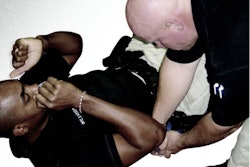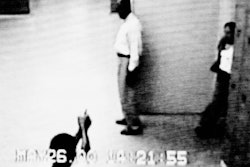The excitement of working with a K-9 partner can sometimes overshadow the amount of care and upkeep these animals need. The dogs' own enthusiasm about their jobs can also make them seem invincible. They're willing to shrug off pain and sometimes keep working past the point of common sense because they love what they do. Of course, just like people they need to maintain overall health to excel in the field.
"These dogs are like professional athletes," says Officer Mark Ficcadenti, a K-9 handler and head trainer for the St. Paul (Minn.) Police Department. "They run hard, they work hard, and they suffer from the same ailments we do."
In knowing this, K-9 officers can prepare for the variety of injuries and illnesses their dogs might suffer from, as well as the day-to-day maintenance they require.
Some of the most important aspects of caring for your dog include maintaining a healthy diet, paying attention to body language and attitude, and adapting his routine as he gets older.
Diet, Nutrition, and Conditioning
As with humans, a dog's source of energy comes from his food. As carnivores, canines thrive most on proteins and animal fats, and less on carbohydrates or vegetables. The highest concentration of these elements can be found in food that contains mostly meat, poultry, and their by-products.
A working dog's diet should consist mostly of fat, with a slightly smaller proportion consisting of proteins, and a scant percentage of it being made up of carbohydrates.
The important thing to remember is that while the best diets are high in protein and fat, a dog must still have a properly balanced diet, which includes essential vitamins and minerals. Separate supplements can be purchased to give to your dog if any are necessary, but well-balanced food should adequately cover all the nutritional bases. It is always best to ask your veterinarian if your dog needs any supplements to his diet.
A dog in peak shape will have firm muscles in his legs and back with a very thin layer of fat over top. He should also have a tucked-in stomach, a light covering of fat over the ribs, and thick, shiny fur. His eyes should be clear and focused, and he should have tough pads on his feet.
Aside from a balanced diet, your partner must be conditioned to work in all types of weather and strenuous situations. Serious physical training is necessary to keep your dog in top shape, and a strict schedule of exercises that complement the tasks he must complete on a day-to-day basis is key to ensuring he stays fit.
To avoid injury and give your partner the best workout, warm-ups, cool-downs, and stretches should be included in the exercise schedule. Warm-up stretches loosen the muscles of your dog's neck, back, and front and hind legs. It is also a good idea to take your dog on a brief walk before his workout, or engage him in any other activity that will get his blood flowing. To keep your dog's interest, focus on different sets of tasks in each workout or training session.
Working with your dog in inclement weather is another important part of conditioning. Ficcadenti suggests that officers keep their dogs' living quarters outside to acclimate them to a variety of weather conditions. He adds that this is also a good idea because it gives your partner space to himself and keeps him motivated to work.
Handling Injuries and Illnesses
In some instances, your dog will fall prey to torn ACLs, stab wounds, and other injuries on the job, as well as a variety of illnesses. Some of the most common illnesses in patrol dogs include bloat, heatstroke, and dehydration. These, in fact, are more common than injuries, but must still be taken seriously and treated as quickly as possible.
It is important to glean as much medical information as possible from the training your department provides from vet technicians or other knowledgeable sources. Knowing canine anatomy and the symptoms of each condition will give you a leg up in treating your dog.
For example, a dog suffering from heatstroke gives off telltale signs that he is sick. Symptoms of heatstroke include pale pink gums, a high heart rate, heavy panting, and a lack of focus or disregard for surroundings. When a handler knows the habits of his K-9, he can quickly tell if something is out of sync and respond accordingly.
No matter how well you treat your animal on the scene, make sure to take him to your veterinarian immediately. Also, make sure to stay up-to-date on treatments and any other important information.
K-9 handlers must also be prepared for any emergencies and should be well-equipped at any time. You can prepare your own first-aid kit to keep in your car with you at all times, or you can purchase pre-made kits from a variety of companies, including K9 Guardian and Elite K9.
Ficcadenti says that the most effective way to keep your dog healthy is to learn to read his actions. "K-9 handlers must be well prepared to recognize the subtleties in their dogs that could potentially be a major health issue," he says. Connecting textbook symptoms with the habits of your dog could be the key to saving your animal.
Caring for Your K-9 After Retirement
While your partner won't need the same type of treatment when he retires, he'll still need special care from you and your family. But you must take certain things about your dog's history and training into consideration.
"What the handler has to be aware of is that there are still certain things that trigger behaviors in the dog, specifically regarding aggression," Ficcadenti says. It is important that handlers make this clear to their family members. Although the dog is no longer working, he is still trained to be at work and must be treated as such by you and your family. As time goes on, your dog will be easier to handle as a household pet, but he will never completely lose his drives or his training.
Jealousy can also be a problem for your dog if you stay in the K-9 unit. Bringing a new dog in the house can confuse your retired partner, and your new dog will probably try to assert dominance over the older dog. While it might be hard to do, you must give the majority of your attention to your new partner-he needs the confidence to do his job effectively.
To combat the jealousy your retired K-9 might feel, encourage your spouse and family members to pay more attention to him.
Another factor to consider in regards to your dog's retirement is the change in his musculature and joints that comes from aging, and the resulting pain he might feel from these changes. While some dogs handle this pain easily, others can become irritated by it. This irritability can lead to aggressive behavior when encountering family members and friends.
A decrease in mobility from joint pain can also cause the dog to panic in threatening or stressful situations. Experts have found that dogs can interpret seemingly innocuous situations as threatening. For example, if a crawling baby is moving too fast for your dog's comfort, he could respond aggressively, putting the child in harm and causing unnecessary stress to the animal.
Talk to your veterinarian about medications that can be administered to alleviate this pain, and consider changing your dog's sleeping arrangements to help him as well.
To keep both you and your K-9 partner happy and effective working companions and to maintain his health into old age it's important to pay attention to any changes and address any possible problems immediately. He'll thank you for it.
How to Care for Your K-9
The excitement of working with a K-9 partner can sometimes overshadow the amount of care and upkeep these animals need. Of course, just like people they need to maintain overall health to excel in the field.









